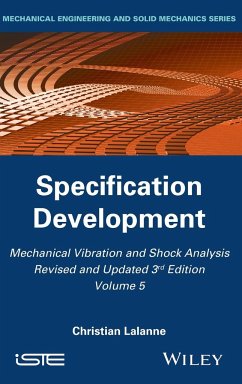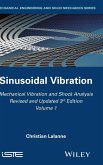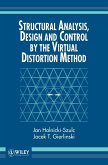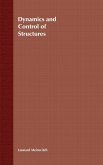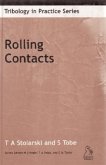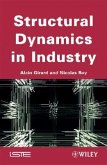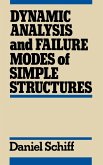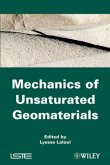Christian Lalanne
Mechanical Vibration and Shock Analysis, Specification Development
Christian Lalanne
Mechanical Vibration and Shock Analysis, Specification Development
- Gebundenes Buch
- Merkliste
- Auf die Merkliste
- Bewerten Bewerten
- Teilen
- Produkt teilen
- Produkterinnerung
- Produkterinnerung
Revision of: Mechanical vibration and shock analysis / Christian Lalanne. Second edition. London: ISTE Ltd; Hoboken, NJ: John Wiley & Sons, Inc., 2009.
Andere Kunden interessierten sich auch für
![Mechanical Vibration and Shock Analysis, Sinusoidal Vibration Mechanical Vibration and Shock Analysis, Sinusoidal Vibration]() Christian LalanneMechanical Vibration and Shock Analysis, Sinusoidal Vibration253,99 €
Christian LalanneMechanical Vibration and Shock Analysis, Sinusoidal Vibration253,99 €![Structural Analysis, Design and Control by the Virtual Distortion Method Structural Analysis, Design and Control by the Virtual Distortion Method]() Jan Holnicki-SzulcStructural Analysis, Design and Control by the Virtual Distortion Method656,99 €
Jan Holnicki-SzulcStructural Analysis, Design and Control by the Virtual Distortion Method656,99 €![Dynamics and Control of Structures Dynamics and Control of Structures]() Leonard MeirovitchDynamics and Control of Structures241,99 €
Leonard MeirovitchDynamics and Control of Structures241,99 €![Rolling Contacts Rolling Contacts]() T A StolarskiRolling Contacts323,99 €
T A StolarskiRolling Contacts323,99 €![Structural Dynamics in Industry Structural Dynamics in Industry]() Alain GirardStructural Dynamics in Industry339,99 €
Alain GirardStructural Dynamics in Industry339,99 €![Dynamic Analysis and Failure Modes of Simple Structures Dynamic Analysis and Failure Modes of Simple Structures]() Daniel SchiffDynamic Analysis and Failure Modes of Simple Structures247,99 €
Daniel SchiffDynamic Analysis and Failure Modes of Simple Structures247,99 €![Mechanics of Unsaturated Geomaterials Mechanics of Unsaturated Geomaterials]() Lyesse LalouiMechanics of Unsaturated Geomaterials223,99 €
Lyesse LalouiMechanics of Unsaturated Geomaterials223,99 €-
-
-
Revision of: Mechanical vibration and shock analysis / Christian Lalanne. Second edition. London: ISTE Ltd; Hoboken, NJ: John Wiley & Sons, Inc., 2009.
Hinweis: Dieser Artikel kann nur an eine deutsche Lieferadresse ausgeliefert werden.
Hinweis: Dieser Artikel kann nur an eine deutsche Lieferadresse ausgeliefert werden.
Produktdetails
- Produktdetails
- Verlag: Wiley
- 3rd Volume 5 edition
- Seitenzahl: 554
- Erscheinungstermin: 15. April 2014
- Englisch
- Abmessung: 240mm x 161mm x 34mm
- Gewicht: 982g
- ISBN-13: 9781848216488
- ISBN-10: 1848216483
- Artikelnr.: 40701794
- Herstellerkennzeichnung
- Libri GmbH
- Europaallee 1
- 36244 Bad Hersfeld
- gpsr@libri.de
- Verlag: Wiley
- 3rd Volume 5 edition
- Seitenzahl: 554
- Erscheinungstermin: 15. April 2014
- Englisch
- Abmessung: 240mm x 161mm x 34mm
- Gewicht: 982g
- ISBN-13: 9781848216488
- ISBN-10: 1848216483
- Artikelnr.: 40701794
- Herstellerkennzeichnung
- Libri GmbH
- Europaallee 1
- 36244 Bad Hersfeld
- gpsr@libri.de
Christian Lalanne is a Consultant Engineer who previously worked as an expert at the French Atomic Energy Authority and who has specialized in the study of vibration and shock for more than 40 years. He has been associated with the new methods of drafting testing specifications and associated informatic tools.
Foreword to Series xiii
Introduction xvii
List of Symbols xxi
Chapter 1 Extreme Response Spectrum of a Sinusoidal Vibration 1
1.1 The effects of vibration 1
1.2 Extreme response spectrum of a sinusoidal vibration 2
1.3 Extreme response spectrum of a swept sine vibration 13
Chapter 2 Extreme Response Spectrum of a Random Vibration 21
2.1 Unspecified vibratory signal 22
2.2 Gaussian stationary random signal 23
2.3 Limit of the ERS at the high frequencies 49
2.4 Response spectrum with up-crossing risk 50
2.5 Comparison of the various formulae 62
2.6 Effects of peak truncation on the acceleration time history 66
2.7 Sinusoidalvibration superimposed on a broadband random vibration 68
2.8 Swept sine superimposed on a broadband random vibration 83
2.9 Swept narrowbands on a wideband random vibration 85
Chapter 3 Fatigue Damage Spectrum of a Sinusoidal Vibration 89
3.1 Fatigue damage spectrum definition 89
3.2 Fatigue damage spectrum of a single sinusoid 92
3.3 Fatigue damage spectum of a periodic signal 96
3.4 General expression for the damage 98
3.5 Fatigue damage with other assumptions on the S-N curve 98
3.6 Fatigue damage generated by a swept sine vibration on a
single-degree-of-freedom linear system 102
3.7 Reduction of test time 121
3.8 Notes on the design assumptions of the ERS and FDS 124
Chapter 4 Fatigue Damage Spectrum of a Random Vibration 125
4.1 Fatigue damage spectrum from the signal as function of time 125
4.2 Fatigue damage spectrum derived from a power spectral density 127
4.3 Simplified hypothesis of Rayleigh's law 132
4.4 Calculation of the fatigue damage spectrum with Dirlik's probability
density 138
4.5 Up-crossing risk fatigue damage spectrum 140
4.6 Reduction of test time 144
4.7 Truncation of the peaks of the "input" acceleration signal 149
4.8 Sinusoidal vibration superimposed on a broadband random vibration 152
4.9 Swept sine superimposed on a broadband random vibration 161
4.10 Swept narrowbands on a broadband random vibration 162
Chapter 5 Fatigue Damage Spectrum of a Shock 165
5.1 General relationship of fatigue damage 165
5.2 Use of shock response spectrum in the impulse zone 167
5.3 Damage created by simple shocks in static zone of the response spectrum
169
Chapter 6 Influence of Calculation Conditions of ERSs and FDSs 171
6.1 Variation of the ERS with amplitude and vibraiton duration 171
6.2 Variation of the FDS with amplitude and duration of vibration 175
6.3 Should ERSs and FDSs be drawn with a linear or logarithmic frequency
step? 175
6.4 With how many points must ERSs and FDSs be calculated? 177
6.5 Difference between ERSs and FDSs calculated from a vibratory signal
according to time and from its PSD 180
6.6 Influence of the number of PSD calculation points on ERS and FDS 187
6.7 Influence of the PSD statistical error on ERS and FDS 192
6.8 Influence of the sampling frequency during ERS and FDS calculation from
a signal on time 193
6.9 Influence of the peak counting method 202
6.10 Influence of a non-zero mean stress on FDS 206
Chapter 7 Tests and Standards 217
7.1 Definitions 217
7.2 Types of tests 218
7.3 What can be expected from a test specification? 223
7.4 Specification types 224
7.5 Standards specifying test tailoring 235
Chapter 8 Uncertainty Factor 243
8.1 Need - definitions 243
8.2 Sources of uncertainty 247
8.3 Statistical aspect of the real environment and of material strength 249
8.4 Statistical uncertainty factor 272
Chapter 9 Aging Factor 293
9.1 Purpose of the aging factor 293
9.2 Aging functions used in reliability 293
9.3 Method for calculating the aging factor 296
9.4 Influence of the aging law's standard deviation 299
9.5 Influence of the aging law mean 300
Chapter 10 Test Factor 301
10.1 Philosophy 301
10.2 Normal distributions 303
10.3 Log-normal distributions 315
10.4 Weibull distributions 318
10.5 Choice of confidence level 320
Chapter 11 Specification Development 321
11.1 Test tailoring 321
11.2 Step 1: analysis of the life-cycle profile. Review of the situations
322
11.3 Step 2: determination of the real environmental data associated with
each situation 324
11.4 Step 3: determination of the environment to be simulated 325
11.5 Step 4: establishment of the test program 356
11.6 Applying this method ot the example of the "round robin" comparative
study 363
11.7 Taking environment into account in project mamagement 366
Chapter 12 Influence of Calculation Conditions of Specification 375
12.1 Choice of the number of points in the specification (PSD) 375
12.2 Influence of the Q factor on specification (outside of time reduction)
378
12.3 Influence of the Q factor on specification when duration id reduced
382
12.4 Validity of a specification established for a Q factor equal to 10
when the real structure has another value 387
12.5 Advantage in the consideration of a variable Q factor for the
calculation of ERSs and FDSs 388
12.6 Influence of the value of parameter b on the specification 390
12.7 Choice of the value of parameter b in the case of material made up of
several components 394
12.8 Influence of temperature on parameter b and constant C 395
12.9 Importance of a factor of 10 between the specification FDS and the
reference FDS (real environment) in a small frequency band 396
12.10 Validity of a specification established by reference to a
one-degree-of-freedom system when real structures are
multi-degree-of-freedom systems 398
Chapter 13 OPther Uses of Extreme Response, Up-Crossing Risk and Fitigue
Damage Spectra 399
13.1 Comparisons of the severity of different vibrations 399
13.2 Swept sine excitation - random vibration transformation 403
13.3 Definition of a random vibration with the same severity as a series of
shocks 408
13.4 Writing a specification only from an ERS (or an URS) 413
13.5 Establishment of a swept sine vibration specification 418
Appendix 421
Formulae 457
Bibliography 481
Index 497
Introduction xvii
List of Symbols xxi
Chapter 1 Extreme Response Spectrum of a Sinusoidal Vibration 1
1.1 The effects of vibration 1
1.2 Extreme response spectrum of a sinusoidal vibration 2
1.3 Extreme response spectrum of a swept sine vibration 13
Chapter 2 Extreme Response Spectrum of a Random Vibration 21
2.1 Unspecified vibratory signal 22
2.2 Gaussian stationary random signal 23
2.3 Limit of the ERS at the high frequencies 49
2.4 Response spectrum with up-crossing risk 50
2.5 Comparison of the various formulae 62
2.6 Effects of peak truncation on the acceleration time history 66
2.7 Sinusoidalvibration superimposed on a broadband random vibration 68
2.8 Swept sine superimposed on a broadband random vibration 83
2.9 Swept narrowbands on a wideband random vibration 85
Chapter 3 Fatigue Damage Spectrum of a Sinusoidal Vibration 89
3.1 Fatigue damage spectrum definition 89
3.2 Fatigue damage spectrum of a single sinusoid 92
3.3 Fatigue damage spectum of a periodic signal 96
3.4 General expression for the damage 98
3.5 Fatigue damage with other assumptions on the S-N curve 98
3.6 Fatigue damage generated by a swept sine vibration on a
single-degree-of-freedom linear system 102
3.7 Reduction of test time 121
3.8 Notes on the design assumptions of the ERS and FDS 124
Chapter 4 Fatigue Damage Spectrum of a Random Vibration 125
4.1 Fatigue damage spectrum from the signal as function of time 125
4.2 Fatigue damage spectrum derived from a power spectral density 127
4.3 Simplified hypothesis of Rayleigh's law 132
4.4 Calculation of the fatigue damage spectrum with Dirlik's probability
density 138
4.5 Up-crossing risk fatigue damage spectrum 140
4.6 Reduction of test time 144
4.7 Truncation of the peaks of the "input" acceleration signal 149
4.8 Sinusoidal vibration superimposed on a broadband random vibration 152
4.9 Swept sine superimposed on a broadband random vibration 161
4.10 Swept narrowbands on a broadband random vibration 162
Chapter 5 Fatigue Damage Spectrum of a Shock 165
5.1 General relationship of fatigue damage 165
5.2 Use of shock response spectrum in the impulse zone 167
5.3 Damage created by simple shocks in static zone of the response spectrum
169
Chapter 6 Influence of Calculation Conditions of ERSs and FDSs 171
6.1 Variation of the ERS with amplitude and vibraiton duration 171
6.2 Variation of the FDS with amplitude and duration of vibration 175
6.3 Should ERSs and FDSs be drawn with a linear or logarithmic frequency
step? 175
6.4 With how many points must ERSs and FDSs be calculated? 177
6.5 Difference between ERSs and FDSs calculated from a vibratory signal
according to time and from its PSD 180
6.6 Influence of the number of PSD calculation points on ERS and FDS 187
6.7 Influence of the PSD statistical error on ERS and FDS 192
6.8 Influence of the sampling frequency during ERS and FDS calculation from
a signal on time 193
6.9 Influence of the peak counting method 202
6.10 Influence of a non-zero mean stress on FDS 206
Chapter 7 Tests and Standards 217
7.1 Definitions 217
7.2 Types of tests 218
7.3 What can be expected from a test specification? 223
7.4 Specification types 224
7.5 Standards specifying test tailoring 235
Chapter 8 Uncertainty Factor 243
8.1 Need - definitions 243
8.2 Sources of uncertainty 247
8.3 Statistical aspect of the real environment and of material strength 249
8.4 Statistical uncertainty factor 272
Chapter 9 Aging Factor 293
9.1 Purpose of the aging factor 293
9.2 Aging functions used in reliability 293
9.3 Method for calculating the aging factor 296
9.4 Influence of the aging law's standard deviation 299
9.5 Influence of the aging law mean 300
Chapter 10 Test Factor 301
10.1 Philosophy 301
10.2 Normal distributions 303
10.3 Log-normal distributions 315
10.4 Weibull distributions 318
10.5 Choice of confidence level 320
Chapter 11 Specification Development 321
11.1 Test tailoring 321
11.2 Step 1: analysis of the life-cycle profile. Review of the situations
322
11.3 Step 2: determination of the real environmental data associated with
each situation 324
11.4 Step 3: determination of the environment to be simulated 325
11.5 Step 4: establishment of the test program 356
11.6 Applying this method ot the example of the "round robin" comparative
study 363
11.7 Taking environment into account in project mamagement 366
Chapter 12 Influence of Calculation Conditions of Specification 375
12.1 Choice of the number of points in the specification (PSD) 375
12.2 Influence of the Q factor on specification (outside of time reduction)
378
12.3 Influence of the Q factor on specification when duration id reduced
382
12.4 Validity of a specification established for a Q factor equal to 10
when the real structure has another value 387
12.5 Advantage in the consideration of a variable Q factor for the
calculation of ERSs and FDSs 388
12.6 Influence of the value of parameter b on the specification 390
12.7 Choice of the value of parameter b in the case of material made up of
several components 394
12.8 Influence of temperature on parameter b and constant C 395
12.9 Importance of a factor of 10 between the specification FDS and the
reference FDS (real environment) in a small frequency band 396
12.10 Validity of a specification established by reference to a
one-degree-of-freedom system when real structures are
multi-degree-of-freedom systems 398
Chapter 13 OPther Uses of Extreme Response, Up-Crossing Risk and Fitigue
Damage Spectra 399
13.1 Comparisons of the severity of different vibrations 399
13.2 Swept sine excitation - random vibration transformation 403
13.3 Definition of a random vibration with the same severity as a series of
shocks 408
13.4 Writing a specification only from an ERS (or an URS) 413
13.5 Establishment of a swept sine vibration specification 418
Appendix 421
Formulae 457
Bibliography 481
Index 497
Foreword to Series xiii
Introduction xvii
List of Symbols xxi
Chapter 1 Extreme Response Spectrum of a Sinusoidal Vibration 1
1.1 The effects of vibration 1
1.2 Extreme response spectrum of a sinusoidal vibration 2
1.3 Extreme response spectrum of a swept sine vibration 13
Chapter 2 Extreme Response Spectrum of a Random Vibration 21
2.1 Unspecified vibratory signal 22
2.2 Gaussian stationary random signal 23
2.3 Limit of the ERS at the high frequencies 49
2.4 Response spectrum with up-crossing risk 50
2.5 Comparison of the various formulae 62
2.6 Effects of peak truncation on the acceleration time history 66
2.7 Sinusoidalvibration superimposed on a broadband random vibration 68
2.8 Swept sine superimposed on a broadband random vibration 83
2.9 Swept narrowbands on a wideband random vibration 85
Chapter 3 Fatigue Damage Spectrum of a Sinusoidal Vibration 89
3.1 Fatigue damage spectrum definition 89
3.2 Fatigue damage spectrum of a single sinusoid 92
3.3 Fatigue damage spectum of a periodic signal 96
3.4 General expression for the damage 98
3.5 Fatigue damage with other assumptions on the S-N curve 98
3.6 Fatigue damage generated by a swept sine vibration on a
single-degree-of-freedom linear system 102
3.7 Reduction of test time 121
3.8 Notes on the design assumptions of the ERS and FDS 124
Chapter 4 Fatigue Damage Spectrum of a Random Vibration 125
4.1 Fatigue damage spectrum from the signal as function of time 125
4.2 Fatigue damage spectrum derived from a power spectral density 127
4.3 Simplified hypothesis of Rayleigh's law 132
4.4 Calculation of the fatigue damage spectrum with Dirlik's probability
density 138
4.5 Up-crossing risk fatigue damage spectrum 140
4.6 Reduction of test time 144
4.7 Truncation of the peaks of the "input" acceleration signal 149
4.8 Sinusoidal vibration superimposed on a broadband random vibration 152
4.9 Swept sine superimposed on a broadband random vibration 161
4.10 Swept narrowbands on a broadband random vibration 162
Chapter 5 Fatigue Damage Spectrum of a Shock 165
5.1 General relationship of fatigue damage 165
5.2 Use of shock response spectrum in the impulse zone 167
5.3 Damage created by simple shocks in static zone of the response spectrum
169
Chapter 6 Influence of Calculation Conditions of ERSs and FDSs 171
6.1 Variation of the ERS with amplitude and vibraiton duration 171
6.2 Variation of the FDS with amplitude and duration of vibration 175
6.3 Should ERSs and FDSs be drawn with a linear or logarithmic frequency
step? 175
6.4 With how many points must ERSs and FDSs be calculated? 177
6.5 Difference between ERSs and FDSs calculated from a vibratory signal
according to time and from its PSD 180
6.6 Influence of the number of PSD calculation points on ERS and FDS 187
6.7 Influence of the PSD statistical error on ERS and FDS 192
6.8 Influence of the sampling frequency during ERS and FDS calculation from
a signal on time 193
6.9 Influence of the peak counting method 202
6.10 Influence of a non-zero mean stress on FDS 206
Chapter 7 Tests and Standards 217
7.1 Definitions 217
7.2 Types of tests 218
7.3 What can be expected from a test specification? 223
7.4 Specification types 224
7.5 Standards specifying test tailoring 235
Chapter 8 Uncertainty Factor 243
8.1 Need - definitions 243
8.2 Sources of uncertainty 247
8.3 Statistical aspect of the real environment and of material strength 249
8.4 Statistical uncertainty factor 272
Chapter 9 Aging Factor 293
9.1 Purpose of the aging factor 293
9.2 Aging functions used in reliability 293
9.3 Method for calculating the aging factor 296
9.4 Influence of the aging law's standard deviation 299
9.5 Influence of the aging law mean 300
Chapter 10 Test Factor 301
10.1 Philosophy 301
10.2 Normal distributions 303
10.3 Log-normal distributions 315
10.4 Weibull distributions 318
10.5 Choice of confidence level 320
Chapter 11 Specification Development 321
11.1 Test tailoring 321
11.2 Step 1: analysis of the life-cycle profile. Review of the situations
322
11.3 Step 2: determination of the real environmental data associated with
each situation 324
11.4 Step 3: determination of the environment to be simulated 325
11.5 Step 4: establishment of the test program 356
11.6 Applying this method ot the example of the "round robin" comparative
study 363
11.7 Taking environment into account in project mamagement 366
Chapter 12 Influence of Calculation Conditions of Specification 375
12.1 Choice of the number of points in the specification (PSD) 375
12.2 Influence of the Q factor on specification (outside of time reduction)
378
12.3 Influence of the Q factor on specification when duration id reduced
382
12.4 Validity of a specification established for a Q factor equal to 10
when the real structure has another value 387
12.5 Advantage in the consideration of a variable Q factor for the
calculation of ERSs and FDSs 388
12.6 Influence of the value of parameter b on the specification 390
12.7 Choice of the value of parameter b in the case of material made up of
several components 394
12.8 Influence of temperature on parameter b and constant C 395
12.9 Importance of a factor of 10 between the specification FDS and the
reference FDS (real environment) in a small frequency band 396
12.10 Validity of a specification established by reference to a
one-degree-of-freedom system when real structures are
multi-degree-of-freedom systems 398
Chapter 13 OPther Uses of Extreme Response, Up-Crossing Risk and Fitigue
Damage Spectra 399
13.1 Comparisons of the severity of different vibrations 399
13.2 Swept sine excitation - random vibration transformation 403
13.3 Definition of a random vibration with the same severity as a series of
shocks 408
13.4 Writing a specification only from an ERS (or an URS) 413
13.5 Establishment of a swept sine vibration specification 418
Appendix 421
Formulae 457
Bibliography 481
Index 497
Introduction xvii
List of Symbols xxi
Chapter 1 Extreme Response Spectrum of a Sinusoidal Vibration 1
1.1 The effects of vibration 1
1.2 Extreme response spectrum of a sinusoidal vibration 2
1.3 Extreme response spectrum of a swept sine vibration 13
Chapter 2 Extreme Response Spectrum of a Random Vibration 21
2.1 Unspecified vibratory signal 22
2.2 Gaussian stationary random signal 23
2.3 Limit of the ERS at the high frequencies 49
2.4 Response spectrum with up-crossing risk 50
2.5 Comparison of the various formulae 62
2.6 Effects of peak truncation on the acceleration time history 66
2.7 Sinusoidalvibration superimposed on a broadband random vibration 68
2.8 Swept sine superimposed on a broadband random vibration 83
2.9 Swept narrowbands on a wideband random vibration 85
Chapter 3 Fatigue Damage Spectrum of a Sinusoidal Vibration 89
3.1 Fatigue damage spectrum definition 89
3.2 Fatigue damage spectrum of a single sinusoid 92
3.3 Fatigue damage spectum of a periodic signal 96
3.4 General expression for the damage 98
3.5 Fatigue damage with other assumptions on the S-N curve 98
3.6 Fatigue damage generated by a swept sine vibration on a
single-degree-of-freedom linear system 102
3.7 Reduction of test time 121
3.8 Notes on the design assumptions of the ERS and FDS 124
Chapter 4 Fatigue Damage Spectrum of a Random Vibration 125
4.1 Fatigue damage spectrum from the signal as function of time 125
4.2 Fatigue damage spectrum derived from a power spectral density 127
4.3 Simplified hypothesis of Rayleigh's law 132
4.4 Calculation of the fatigue damage spectrum with Dirlik's probability
density 138
4.5 Up-crossing risk fatigue damage spectrum 140
4.6 Reduction of test time 144
4.7 Truncation of the peaks of the "input" acceleration signal 149
4.8 Sinusoidal vibration superimposed on a broadband random vibration 152
4.9 Swept sine superimposed on a broadband random vibration 161
4.10 Swept narrowbands on a broadband random vibration 162
Chapter 5 Fatigue Damage Spectrum of a Shock 165
5.1 General relationship of fatigue damage 165
5.2 Use of shock response spectrum in the impulse zone 167
5.3 Damage created by simple shocks in static zone of the response spectrum
169
Chapter 6 Influence of Calculation Conditions of ERSs and FDSs 171
6.1 Variation of the ERS with amplitude and vibraiton duration 171
6.2 Variation of the FDS with amplitude and duration of vibration 175
6.3 Should ERSs and FDSs be drawn with a linear or logarithmic frequency
step? 175
6.4 With how many points must ERSs and FDSs be calculated? 177
6.5 Difference between ERSs and FDSs calculated from a vibratory signal
according to time and from its PSD 180
6.6 Influence of the number of PSD calculation points on ERS and FDS 187
6.7 Influence of the PSD statistical error on ERS and FDS 192
6.8 Influence of the sampling frequency during ERS and FDS calculation from
a signal on time 193
6.9 Influence of the peak counting method 202
6.10 Influence of a non-zero mean stress on FDS 206
Chapter 7 Tests and Standards 217
7.1 Definitions 217
7.2 Types of tests 218
7.3 What can be expected from a test specification? 223
7.4 Specification types 224
7.5 Standards specifying test tailoring 235
Chapter 8 Uncertainty Factor 243
8.1 Need - definitions 243
8.2 Sources of uncertainty 247
8.3 Statistical aspect of the real environment and of material strength 249
8.4 Statistical uncertainty factor 272
Chapter 9 Aging Factor 293
9.1 Purpose of the aging factor 293
9.2 Aging functions used in reliability 293
9.3 Method for calculating the aging factor 296
9.4 Influence of the aging law's standard deviation 299
9.5 Influence of the aging law mean 300
Chapter 10 Test Factor 301
10.1 Philosophy 301
10.2 Normal distributions 303
10.3 Log-normal distributions 315
10.4 Weibull distributions 318
10.5 Choice of confidence level 320
Chapter 11 Specification Development 321
11.1 Test tailoring 321
11.2 Step 1: analysis of the life-cycle profile. Review of the situations
322
11.3 Step 2: determination of the real environmental data associated with
each situation 324
11.4 Step 3: determination of the environment to be simulated 325
11.5 Step 4: establishment of the test program 356
11.6 Applying this method ot the example of the "round robin" comparative
study 363
11.7 Taking environment into account in project mamagement 366
Chapter 12 Influence of Calculation Conditions of Specification 375
12.1 Choice of the number of points in the specification (PSD) 375
12.2 Influence of the Q factor on specification (outside of time reduction)
378
12.3 Influence of the Q factor on specification when duration id reduced
382
12.4 Validity of a specification established for a Q factor equal to 10
when the real structure has another value 387
12.5 Advantage in the consideration of a variable Q factor for the
calculation of ERSs and FDSs 388
12.6 Influence of the value of parameter b on the specification 390
12.7 Choice of the value of parameter b in the case of material made up of
several components 394
12.8 Influence of temperature on parameter b and constant C 395
12.9 Importance of a factor of 10 between the specification FDS and the
reference FDS (real environment) in a small frequency band 396
12.10 Validity of a specification established by reference to a
one-degree-of-freedom system when real structures are
multi-degree-of-freedom systems 398
Chapter 13 OPther Uses of Extreme Response, Up-Crossing Risk and Fitigue
Damage Spectra 399
13.1 Comparisons of the severity of different vibrations 399
13.2 Swept sine excitation - random vibration transformation 403
13.3 Definition of a random vibration with the same severity as a series of
shocks 408
13.4 Writing a specification only from an ERS (or an URS) 413
13.5 Establishment of a swept sine vibration specification 418
Appendix 421
Formulae 457
Bibliography 481
Index 497

